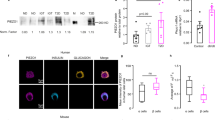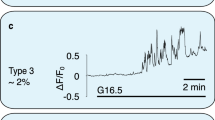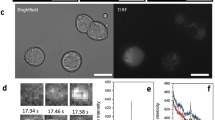Abstract
The major physiological stimulus for the secretion of insulin from the pancreatic β-cell is an increase in the plasma glucose concentration. It is well established that glucose-stimulated insulin secretion is associated with the appearance of electrical activity in the β-cell1,2; glucose concentrations above the threshold level for insulin release produce a slow membrane depolarization followed by either oscillatory bursts of action potentials (5–15 mM glucose) or continuous spiking (>16mM glucose). Tracer flux studies3 and microelectrode measurements using intact islets of Langerhans4 have indicated that the initial depolarization induced by glucose is caused by a decrease in the resting membrane permeability to potassium. Evidence also suggests that the electrical5, ionic6 and secretory responses7,8 to glucose are mediated by the metabolism of the sugar within the β-cell. By using cell-attached membrane patches9 from isolated rat pancreatic β-cells, we have now identified a potassium channel (G-channel) that is active at the resting potential and is inhibited by glucose. Closure of this channel requires glucose metabolism. This is the first report of a potassium channel whose activity is modulated by glucose, and which may couple metabolic and ionic events involved in the secretion of insulin.
This is a preview of subscription content, access via your institution
Access options
Subscribe to this journal
Receive 51 print issues and online access
$199.00 per year
only $3.90 per issue
Buy this article
- Purchase on Springer Link
- Instant access to full article PDF
Prices may be subject to local taxes which are calculated during checkout
Similar content being viewed by others
References
Dean, P. M. & Matthews, E. K. J. Physiol., Lond. 210, 225–264 (1970).
Meissner, H. P. & Schmelz, H. Pflügers Arch. ges. Physiol. 351, 195–206 (1974).
Sehlin, J. & Taljedal, I-B. Nature 253, 635–636 (1975).
Atwater, I., Ribalet, B. & Rojas, E. J. Physiol., Lond. 278, 117–139 (1978).
Dean, P. M., Matthews, E. K. & Sakamoto, Y. J. Physiol., Lond. 246, 459–478 (1978).
Henquin, J. C. Biochem. J. 186, 541–550 (1980).
Ashcroft, S. J. H. Diabetologia 18, 5–15 (1980).
Hedeskov, C. J. Physiol. Rev. 60, 442–507 (1980).
Hamil, O. P., Marty, A., Neher, E., Sakmann, B. & Sigworth, F. Pflügers Arch. ges. Physiol. 391, 85–100 (1981).
Nakane, P. K. & Pierce, G. B. J. Cell Biol. 33, 307–318 (1967).
Ashcroft, S. J. H. & Crossley, J. R. Diabetologia 11, 279–284 (1975).
Lernmark, Å. Diabetologia 10, 431–438 (1974).
Sakmann, B. & Neher, E. in Single-Channel Recording, 37–51 (Plenum, New York, 1984).
Coll-Garcia, E. & Gill, J. R. Diabetologia 5, 61–66 (1969).
Lernmerk, Å et al. Diabetologia 19, 445–451 (1980).
Christie, M. R. & Ashcroft, S. J. H. Biochem. J. 218, 87–99 (1984).
Fenwick, E. M., Marty, A. & Neher, E. J. Physiol., Lond. 331, 577–597 (1982).
Author information
Authors and Affiliations
Rights and permissions
About this article
Cite this article
Ashcroft, F., Harrison, D. & Ashcroft, S. Glucose induces closure of single potassium channels in isolated rat pancreatic β-cells. Nature 312, 446–448 (1984). https://doi.org/10.1038/312446a0
Received:
Accepted:
Issue Date:
DOI: https://doi.org/10.1038/312446a0
This article is cited by
-
Nav1.7 as a chondrocyte regulator and therapeutic target for osteoarthritis
Nature (2024)
-
HCV affects KATP channels through GnT-IVa-mediated N-glycosylation of GLUT2 on the surface of pancreatic β-cells leading to impaired insulin secretion
Endocrine (2023)
-
Maturation of beta cells: lessons from in vivo and in vitro models
Diabetologia (2022)
-
Glucose and NAADP trigger elementary intracellular β-cell Ca2+ signals
Scientific Reports (2021)
-
Expression of truncated Kir6.2 promotes insertion of functionally inverted ATP-sensitive K+ channels
Scientific Reports (2021)
Comments
By submitting a comment you agree to abide by our Terms and Community Guidelines. If you find something abusive or that does not comply with our terms or guidelines please flag it as inappropriate.



